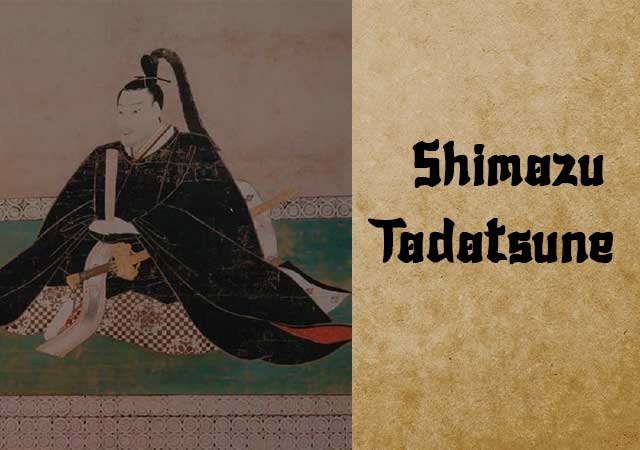
Shimazu Tadatsune, a prominent figure of the early Edo Period, held significant wealth and power, boasting a stipend of 605,000 koku. Born in 1576, he was designated as the heir to the Shimazu clan shortly before the Battle of Sekigahara, where his father fought on the losing side. Despite his uncle Yoshihisa being the primary successor to the clan's leadership, his lack of heirs led to Tadatsune's appointment as successor due to his other uncle Hisakazu's passing in Korea. Assuming control in 1602, Tadatsune's father retained much of the authority until his demise in 1619.
The Shimazu clan's military prowess was renowned, and Tadatsune himself was celebrated for his valor. Notably, during Toyotomi Hideyoshi’s Korean Campaign, he and his father led an army of 8,000 samurai, repelling a Chinese Ming army of 100,000 soldiers.
In 1602, following the Battle of Sekigahara, Tadatsune pledged allegiance to Tokugawa Ieyasu, symbolizing loyalty, and was honored with the name Matsudaira Iehisa. This was a significant gesture as Matsudaira was Ieyasu’s original family name, and Tadatsune also adopted the first part of Ieyasu’s name as his given name, signifying a deep honor.
Tadatsune diligently worked to ensure the Shimazu clan's prosperity, rooting out corruption and disloyalty among his retainers. He strategically annexed the Ryukyu (Okinawan) Islands in the mid-1609, allowing them semi-independence to facilitate trade with China, which believed the islands were under their control. This decision bolstered the Shimazu clan's economic strength and positioned Japan favorably in trade affairs.
Interestingly, the trade activities associated with the Ryukyu Islands are believed to have introduced cockroaches to Japan, as these insects stowed away among the traded items and subsequently spread across the nation. Shimazu Tadatsune passed away on April 7, 1638, at the age of 62.
See also
-
Yamagata Masakage

Masakage was one of Takeda Shingen’s most loyal and capable commanders. He was included in the famous list of the “Twenty-Four Generals of Takeda Shingen” and also belonged to the inner circle of four especially trusted warlords known as the Shitennō.
-
Yagyu Munenori

Yagyū Munenori began his service under Tokugawa Ieyasu while his father, Yagyū Muneyoshi, was still at his side. In 1600, Munenori took part in the decisive Battle of Sekigahara. As early as 1601, he was appointed a kenjutsu instructor to Tokugawa Hidetada, Ieyasu’s son, who later became the second shogun of the Tokugawa clan.
-
Yagyu Muneyoshi

A samurai from Yamato Province, he was born into a family that had been defeated in its struggle against the Tsutsui clan. Muneyoshi first took part in battle at the age of sixteen. Due to circumstances beyond his control, he was forced to enter the service of the Tsutsui house and later served Miyoshi Tōkei. He subsequently came under the command of Matsunaga Hisahide and in time became a vassal first of Oda and later of Toyotomi.
-
Endo Naozune

Naozune served under Azai Nagamasa and was one of the clan’s leading vassals, renowned for his bravery and determination. He accompanied Nagamasa during his first meeting with Oda Nobunaga and at that time asked for permission to kill Nobunaga, fearing him as an extremely dangerous man; however, Nagamasa did not grant this request.
-
Hosokawa Sumimoto

Sumimoto came from the Hosokawa clan: he was the biological son of Hosokawa Yoshiharu and at the same time the adopted son of Hosokawa Masamoto, the heir of Hosokawa Katsumoto, one of the principal instigators of the Ōnin War. Masamoto was homosexual, never married, and had no children of his own. At first he adopted Sumiyuki, a scion of the aristocratic Kujō family, but this choice provoked dissatisfaction and sharp criticism from the senior vassals of the Hosokawa house. As a result, Masamoto changed his decision and proclaimed Sumimoto as his heir, a representative of a collateral branch of the Hosokawa clan that had long been based in Awa Province on the island of Shikoku. Almost immediately after this, the boy became entangled in a complex and bitter web of political intrigue.
-
Honda Masanobu

Masanobu initially belonged to the retinue of Tokugawa Ieyasu, but later entered the service of Sakai Shōgen, a daimyo and priest from Ueno. This shift automatically made him an enemy of Ieyasu, who was engaged in conflict with the Ikkō-ikki movement in Mikawa Province. After the Ikkō-ikki were defeated in 1564, Masanobu was forced to flee, but in time he returned and once again entered Ieyasu’s service. He did not gain fame as a military commander due to a wound sustained in his youth; nevertheless, over the following fifty years he consistently remained loyal to Ieyasu.
-
Honda Masazumi

Masazumi was the eldest son of Honda Masanobu. From a young age, he served Tokugawa Ieyasu alongside his father, taking part in the affairs of the Tokugawa house and gradually gaining experience in both military and administrative matters. At the decisive Battle of Sekigahara in 1600, Masazumi was part of the core Tokugawa forces, a clear sign of the high level of trust Ieyasu placed in him. After the campaign ended, he was given a highly sensitive assignment—serving in the guard of the defeated Ishida Mitsunari, one of Tokugawa’s principal enemies—an obligation that required exceptional reliability and caution.
-
Hojo Shigetoki

Hōjō Shigetoki, the third son of Hōjō Yoshitoki, was still very young—only five years old—when his grandfather Tokimasa became the first member of the Hōjō clan to assume the position of shogunal regent.

